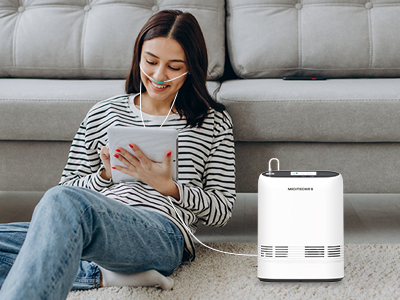05 May 2024
10 liter oxygen concentrator are capable of providing a higher flow rate compared to standard concentrators, making them suitable for patients with greater oxygen needs.

Power Consumption of 10 Liter Oxygen Concentrators
A. Electrical Requirements
Voltage: Most 10-liter oxygen concentrators operate on standard household voltage, typically 110-120 volts in the United States and 220-240 volts in other regions.
Amperage: The amperage required by a 10-liter oxygen concentrator varies depending on the model but typically ranges from 4 to 10 amps.
B. Energy Consumption
Watts: The power consumption of a 10-liter oxygen concentrator is measured in watts, with most models consuming between 400 and 1200 watts.
Kilowatt-Hours (kWh): Energy consumption is often expressed in kilowatt-hours (kWh), which represents the amount of energy used over time. Higher flow rates and continuous operation result in higher kWh usage.
Factors Affecting Power Usage
A. Flow Rate Settings
Higher flow rates require more power to deliver the prescribed amount of oxygen. Patients using higher flow rates will experience increased power consumption.
B. Continuous vs. Pulse Flow Mode
Continuous flow mode, which provides a constant flow of oxygen, typically consumes more power than pulse flow mode, where oxygen is delivered in short bursts based on the patient's breathing pattern.
Comparison with Other Oxygen Concentrator Sizes
A. 5-Liter Oxygen Concentrators
10-liter oxygen concentrators generally consume more power than 5-liter models due to the higher flow rate capacity.
B. 15-Liter Oxygen Concentrators
15-liter oxygen concentrators are larger and consume more power than 10-liter models, making them suitable for patients with extremely high oxygen requirements.

Calculating Power Usage
A. Understanding Manufacturer Specifications
Refer to the manufacturer's specifications to determine the exact power consumption of a specific 10-liter oxygen concentrator model.
B. Estimating Monthly Electricity Costs
Multiply the power consumption in kilowatts by the number of hours the concentrator is used daily, then multiply by the electricity rate per kilowatt-hour to estimate monthly electricity costs.
Power Saving Tips
A. Optimal Use of Settings
Use the lowest effective flow rate setting to minimize power consumption while still meeting the patient's oxygen therapy needs.
B. Energy-Efficient Features
Look for energy-saving features such as sleep mode or auto-off functions that can help reduce power usage during periods of inactivity.
Backup Power Options
A. Uninterruptible Power Supply (UPS)
Invest in a UPS device to provide backup power in case of outages, ensuring continuous oxygen therapy for the patient.
B. Portable Generators
Consider using a portable generator as a backup power source during extended power outages, especially in areas prone to frequent power disruptions.
Conclusion
A. Importance of Power Management
Understanding the power consumption of a 10-liter oxygen concentrator is crucial for ensuring uninterrupted therapy and managing electricity costs.
B. Emergency Procedures
By following these tips and understanding the factors affecting power usage, patients and caregivers can ensure that their 10-liter oxygen concentrator operates safely and efficiently, providing the necessary oxygen therapy for those in need.
Keywords: oxygen concentrator
Originally published 05 May 2024, updated 05 May 2024.